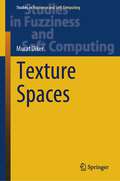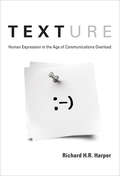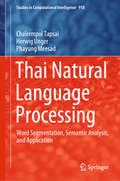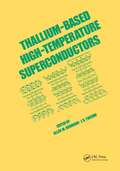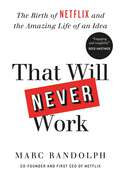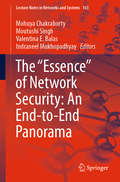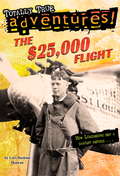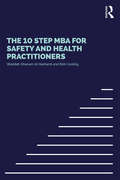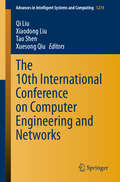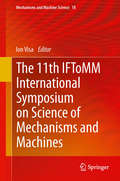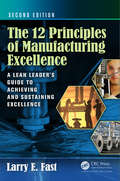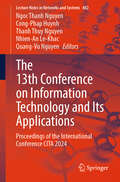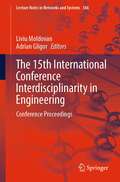- Table View
- List View
Texture Spaces (Studies in Fuzziness and Soft Computing #411)
by Murat DikerThis book provides a complete framework for the fundamental concepts and results of texture spaces and its applications. The principal aim is to present a comprehensive arguments due to connections among the textures, fuzzy sets and rough sets. In this context, direlations, fuzzy direlations and fuzzy relations constitute a bridge for the remarkable observations on rough set theory. In a more general setting, the approximation operators are also inspected for fuzzy rough set models with two domains of discourse. Since the book is self-contained and reader-friendly, the respected researchers may utilize this source for further investigations of the necessary results for their studies on rough set theory using textures. Therefore, prospective readers are not only mathematicians who interest in purely mathematical theories related to textures, but also engineers of information sciences who need more information for their interdisciplinary studies with respect to rough sets and fuzzy sets.
Texture: Human Expression in the Age of Communications Overload (The\mit Press Ser.)
by Richard H. HarperWhy we complain about communication overload even as we seek new ways to communicate.Our workdays are so filled with emails, instant messaging, and RSS feeds that we complain that there's not enough time to get our actual work done. At home, we are besieged by telephone calls on landlines and cell phones, the beeps that signal text messages, and work emails on our BlackBerrys. It's too much, we cry (or type) as we update our Facebook pages, compose a blog post, or check to see what Shaquille O'Neal has to say on Twitter. In Texture, Richard Harper asks why we seek out new ways of communicating even as we complain about communication overload.Harper describes the mistaken assumptions of developers that “more” is always better and argues that users prefer simpler technologies that allow them to create social bonds. Communication is not just the exchange of information. There is a texture to our communicative practices, manifest in the different means we choose to communicate (quick or slow, permanent or ephemeral).
Texturising: Defects, Causes, Effects, Remedies and Prevention through Quality Management
by H. V. Sreenivasamurthy B. PurushothamaDrawing on the expertise of both academic and industry professionals, this book details all the fundamental aspects of yarn texturizing technology. From the origins of texturizing to machinery types, process control, quality testing, and management systems, the topics covered in this book serves as a guide to understanding and improving industry practices. Focusing on common challenges and solutions, this book is aimed at students studying man-made fibers and textiles, as well as shop-floor personnel navigating the day-to-day issues of texturizing units in India. The subject matter of this book also discusses: Types and Advantages of Texturised Yarns Work and Total Quality Management Training and Education of People on Work Wickability Tests Evaluation of Physical Bulk of Air-Texturised Yarns Print edition not for sale in South Asia (India, Sri Lanka, Nepal, Bangladesh, Pakistan or Bhutan)
Thai Natural Language Processing: Word Segmentation, Semantic Analysis, and Application (Studies in Computational Intelligence #918)
by Phayung Meesad Herwig Unger Chalermpol TapsaiThis book presents comprehensive solutions for readers wanting to develop their own Natural Language Processing projects for the Thai language. Starting from the fundamental principles of Thai, it discusses each step in Natural Language Processing, and the real-world applications. In addition to theory, it also includes practical workshops for readers new to the field who want to start programming in Natural Language Processing. Moreover, it features a number of new techniques to provide readers with ideas for developing their own projects. The book details Thai words using phonetic annotation and also includes English definitions to help readers understand the content.
Thallium-Based High-Tempature Superconductors
by Alien M. HermannProvides information on all chemical, physical and material aspects of this class of cuprates, and covers their applications. This work provides data on the chemistry, solid-state chemistry, handling and safety requirements of thallium.
Thank a Farmer
by Maria GianferrariInfused with jubilance and warmth, this luminous, lyrical picture book celebrates the people and the work that put food on our tables. Bread, milk, wool, fruits, and vegetables: things that fill our day to day lives. But where, and who, do they come from? Across wheat fields and city rooftop gardens, mushroom beds and maple forests, Thank a Farmer traces the food and clothing that a family uses back to the people who harvested and created them. With Maria Gianferrari’s informed and poetic text and monumental artwork from Monica Mikai, Thank a Farmer gently emphasizes the importance of agriculture in our day-to-day lives and reminds readers to give thanks to farmworkers around the world.
That Crazy Eddie and the Science Project of Doom
by Judy CoxBest friends Matt and Eddie have a falling out that threatens to ruin their science fair project. Includes instructions for making a model of an erupting volcano.
That Used to Be Us: How America Fell Behind in the World It Invented and How We Can Come Back
by Thomas L. Friedman Michael MandelbaumAmerica is in trouble. We face four major challenges on which our future depends, and we are failing to meet them -- and if we delay any longer, soon it will be too late for us to pass along the American dream to future generations. In That Used to Be Us, Thomas L. Friedman, one of our most influential columnists, and Michael Mandelbaum, one of our leading foreign policy thinkers, offer both a wake-up call and a call to collective action. They analyze the four challenges we face -- globalization, the revolution in information technology, the nation's chronic deficits, and our pattern of excessive energy consumption -- and spell out what we need to do now to sustain the American dream and preserve American power in the world. They explain how the end of the Cold War blinded the nation to the need to address these issues seriously, and how China's educational successes, industrial might, and technological prowess remind us of the ways in which "that used to be us. " They explain how the paralysis of our political system and the erosion of key American values have made it impossible for us to carry out the policies the country urgently needs. And yet Friedman and Mandelbaum believe that the recovery of American greatness is within reach. They show how America's history, when properly understood, offers a five-part formula for prosperity that will enable us to cope successfully with the challenges we face. They offer vivid profiles of individuals who have not lost sight of the American habits of bold thought and dramatic action. They propose a clear way out of the trap into which the country has fallen, a way that includes the rediscovery of some of our most vital traditions and the creation of a new thirdparty movement to galvanize the country. That Used to Be Us is both a searching exploration of the American condition today and a rousing manifesto for American renewal.
That Will Never Work: The Birth of Netflix by the first CEO and co-founder Marc Randolph
by Marc RandolphIn the tradition of Phil Knight's Shoe Dog comes the incredible untold story of how Netflix went from concept to company - all revealed by co-founder and first CEO Marc Randolph.Once upon a time, brick-and-mortar video stores were king. Late fees were ubiquitous, video-streaming unheard of, and widespread DVD adoption seemed about as imminent as flying cars. These were the widely accepted laws of the land in 1997 when Marc Randolph had an idea. It was a simple thought - leveraging the internet to rent movies - and was just one of many more proposals, like personalised baseball bats and a shampoo delivery service, that Randolph would pitch to his business partner, Reed Hastings, on their commute to work each morning. But Hastings was intrigued, and the pair - with Hastings as the primary investor and Randolph as the CEO - founded a company. Now with over 150 million subscribers, Netflix's triumph feels inevitable but the twenty-first century's most disruptive start-up began with few believers and calamity at every turn. From having to pitch his own mother on being an early investor, to the motel conference room that served as a first office, to server crashes on launch day, to the now-infamous meeting when they pitched Blockbuster to acquire them, Marc Randolph's transformational journey exemplifies how anyone with grit, gut instincts and determination can change the world - even with an idea that many think will never work. What emerges, however, isn't just the inside story of one of the world's most iconic companies. Full of counter-intuitive concepts and written in binge-worthy prose, it answers some of our most fundamental questions about taking that leap of faith in business or in life: How do you begin? How do you weather disappointment and failure? How do you deal with success? What even is success? From idea generation to team building to knowing when it's time to let go, That Will Never Work is not only the ultimate follow-your-dreams parable but also one of the most dramatic and insightful entrepreneurial stories of our time. (p) 2019 Octopus Publishing Group
That Will Never Work: The Birth of Netflix by the first CEO and co-founder Marc Randolph
by Marc RandolphIn the tradition of Phil Knight's Shoe Dog comes the incredible untold story of how Netflix went from concept to company - all revealed by co-founder and first CEO Marc Randolph."Engaging and insightful." --Reed Hastings, CEO of Netflix "As the founding CEO, Marc Randolph's leadership defined the culture of Netflix and laid the groundwork for successive, global revolutions in how we make and consume entertainment." --Gina Keating, author of Netflixed: The Epic Battle for America's Eyeballs "Charming, fascinating and very funny. If you've ever wondered how to turn an idea into a global household name, Marc Randolph will demystify the world of Silicon Valley start-ups, and make you laugh a lot along the way." --Decca Aitkenhead, The Sunday Times "A charming first-person account of the early days of one of the most successful tech start-ups ever. An engaging read that will engross any would-be entrepreneur." --The Washington PostOnce upon a time, brick-and-mortar video stores were king. Late fees were ubiquitous, video-streaming unheard of, and widespread DVD adoption seemed about as imminent as flying cars. These were the widely accepted laws of the land in 1997 when Marc Randolph had an idea. It was a simple thought - leveraging the internet to rent movies - and was just one of many more proposals, like personalised baseball bats and a shampoo delivery service, that Randolph would pitch to his business partner, Reed Hastings, on their commute to work each morning. But Hastings was intrigued, and the pair - with Hastings as the primary investor and Randolph as the CEO - founded a company. Now with over 150 million subscribers, Netflix's triumph feels inevitable but the twenty-first century's most disruptive start-up began with few believers and calamity at every turn. From having to pitch his own mother on being an early investor, to the motel conference room that served as a first office, to server crashes on launch day, to the now-infamous meeting when they pitched Blockbuster to acquire them, Marc Randolph's transformational journey exemplifies how anyone with grit, gut instincts and determination can change the world - even with an idea that many think will never work. What emerges, however, isn't just the inside story of one of the world's most iconic companies. Full of counter-intuitive concepts and written in binge-worthy prose, it answers our most fundamental questions about taking that leap of faith in business or in life: How do you begin? How do you weather disappointment and failure? How do you deal with success? What even is success? From idea generation to team building to knowing when it's time to let go, That Will Never Work is not only the ultimate follow-your-dreams parable but also one of the most dramatic and insightful entrepreneurial stories of our time. "Marc wastes no time cutting through the noise. He understands what is important whether it is your product, your marketing, or your business plan. A remarkable and one of a kind visionary." --Mitch Lowe, founder of RedBox and CEO of MoviePass "An entertaining chronicle of creativity, luck, and unflagging perseverance." --Kirkus
The Mechanics and Reliability of Films, Multilayers and Coatings
by Matthew R. Begley John W. HutchinsonA wide variety of applications ranging from microelectronics to turbines for propulsion and power generation rely on films, coatings, and multilayers to improve performance. As such, the ability to predict coating failure - such as delamination (debonding), mud-cracking, blistering, crack kinking, and the like - is critical to component design and development. This work compiles and organizes decades of research that established the theoretical foundation for predicting such failure mechanisms, and clearly outlines the methodology needed to predict performance. Detailed coverage of cracking in multilayers is provided, with an emphasis on the role of differences in thermoelastic properties between the layers. The comprehensive theoretical foundation of the book is complemented by easy-to-use analysis codes designed to empower novices with the tools needed to simulate cracking; these codes enable not only precise quantitative reproduction of results presented graphically in the literature, but also the generation of new results for more complex multilayered systems.
The "Essence" of Network Security: An End-to-End Panorama (Lecture Notes in Networks and Systems #163)
by Valentina E. Balas Mohuya Chakraborty Moutushi Singh Indraneel MukhopadhyayThis edited book provides an optimal portrayal of the principles and applications related to network security. The book is thematically divided into five segments: Part A describes the introductory issues related to network security with some concepts of cutting-edge technologies; Part B builds from there and exposes the readers to the digital, cloud and IoT forensics; Part C presents readers with blockchain and cryptography techniques; Part D deals with the role of AI and machine learning in the context of network security. And lastly, Part E is written on different security networking methodologies. This is a great book on network security, which has lucid and well-planned chapters. All the latest security technologies are thoroughly explained with upcoming research issues. Details on Internet architecture, security needs, encryption, cryptography along with the usages of machine learning and artificial intelligence for network security are presented in a single cover. The broad-ranging text/reference comprehensively surveys network security concepts, methods, and practices and covers network security policies and goals in an integrated manner. It is an essential security resource for practitioners in networks and professionals who develop and maintain secure computer networks.
The $25,000 Flight
by Wesley Lowe Lori Haskins HouranThe most exciting adventures are the ones that really happened! This brand-new Totally True Adventures book follow America's first superstar pilot, Charles Lindbergh. In the 1920s, flying was brand new--and very dangerous. A $25,000 prize for the first flight from New York to Paris went unclaimed for years. Many teams tried. And many teams failed. Still, Charles Lindbergh felt he had a shot at the prize. He wasn't famous. He wasn't rich. But he was determined. He'd cross the ocean in a tiny plane . . . and he'd do it all by himself! After you've read the story, don't miss the bonus content with extra facts, a timeline, and more 20th century history, geography, and science-tie-ins!From the Trade Paperback edition.
The (Mostly) True Story of Cleopatra's Needle
by Dan GutmanFrom the author of the My Weird School books, an adventure story that spans centuries and continents.In Central Park, New York, stands Cleopatra&’s Needle. But what do you know about? Did you know that thousands of people worked in 1461 BCE to build it? Then hundreds more moved it, and erected it in Alexandria, where it stood for 3,000 years? So how did a monolith weighing over 200 tons get moved all the way to New York City—and in the 19th Century, no less? In this historical fiction account by bestselling author Dan Gutman, five kids who watched the Needle at each phase of its history recount the daring story of how something that seemed to be impossible –and that nearly ended in disaster—finally succeeded against all odds. Including photos, diagrams, and illustrations, this book will leave history lovers and fans of problem solving astounded at all that was accomplished. And best of all, it will leave middle grade readers feeling they&’ve just watched a really good movie—they&’ll hardly even realize they were reading.A Junior Library Guild Gold Standard Selection
The 10 Principles of Food Industry Sustainability
by Cheryl J. BaldwinAlthough the food industry is beginning to make headway with its sustainability initiatives, substantially more progress is needed in order to feed the world's growing population sustainably. The challenge is that the topic of sustainability can seem overwhelming and there is limited information that is specific to the food industry.Written by an experienced food industry professional with years of experience in sustainability, The 10 Principles of Food Industry Sustainability inspires and informs the progress required to nourish the population, revitalize natural resources, enhance economic development, and close resource loops. The book makes this complex topic approachable and actionable by identifying the most pressing sustainability priorities across the entire food supply chain and showing, with tools and examples, how producers, processors, packers, distributors, marketers and retailers all play a role in advancing improvement. The book begins with an overview of the Principles of sustainability in the food industry: what they are and why they matter. Subsequent chapters focus on each of the Ten Principles in detail: how they relate to the food industry, their global relevance (including their environmental, health, and social impacts), and the best practices to achieve the potential of meaningful and positive progress that the Principles offer. Specific examples from industry are presented in order to provide scalable solutions and bring the concepts to life, along with top resources for further exploration.The Principles, practices, and potential of sustainability in the food industry covered in this book are designed to be motivating and to offer a much-needed and clear way forward towards a sustainable food supply.
The 10 Step MBA for Safety and Health Practitioners
by Waddah S Ghanem Al Hashmi Rob CoolingAs an Occupational Safety and Health (OSH) practitioner have you ever wondered "How can I shape my career trajectory to reach a C-suite position in business?" Or perhaps—for those who do not aspire to positions of this nature; "How can I develop my ability to persuade and influence top management more effectively?" The 10 Step MBA for Safety and Health Practitioners answers these questions to enable you to achieve your personal and professional OSH goals. Presented over 10 steps encompassing a typical MBA programme, a transformational model establishes key themes which are deemed critical in understanding the world of business to exert greater influence: Strategic – aligning OSH to the overall direction of a business and creating a lasting OSH purpose that all stakeholders can relate to Cross-functional – understanding the different parts of an organisation and integrating OSH within business functions and ways of working Distinctive – looking for creative new ways of presenting OSH data and information to generate interest and enthusiasm. From strategy and leadership to organisational behaviour and human resource management, from marketing and brand management to interpersonal skills, this book shows you how to combine the best of your specialist knowledge with important business tools, so you can embed OSH at the heart of your company. The book is an indispensable reference for OSH practitioners who want to make a positive change in their careers and become more effective in influencing and leading change.
The 10th International Conference on Computer Engineering and Networks (Advances in Intelligent Systems and Computing #1274)
by Xuesong Qiu Qi Liu Xiaodong Liu Tao ShenThis book contains a collection of the papers accepted by the CENet2020 – the 10th International Conference on Computer Engineering and Networks held on October 16-18, 2020 in Xi’an, China. The topics focus but are not limited to Internet of Things and Smart Systems, Artificial Intelligence and Applications, Communication System Detection, Analysis and Application, and Medical Engineering and Information Systems. Each part can be used as an excellent reference by industry practitioners, university faculties, research fellows and undergraduates as well as graduate students who need to build a knowledge base of the most current advances and state-of-practice in the topics covered by this conference proceedings. This will enable them to produce, maintain, and manage systems with high levels of trustworthiness and complexity.
The 10th International Conference on Engineering, Project, and Production Management (Lecture Notes in Mechanical Engineering)
by Kriengsak Panuwatwanich Chien-Ho KoThis book gathers the proceedings of the EPPM 2019 conference, and highlights innovative work by researchers and practitioners active in various industries around the globe. Recent advances in science and technology have made it possible to seamlessly connect and integrate various elements of engineering systems, and opened the door for innovations that have transformed how we live and work. While these developments have yielded enhanced efficiency and numerous improvements in our current practices, the problems caused by the increased complexity of these integrated systems can be extremely difficult. Accordingly, solving these problems involves applying cross-disciplinary expertise to address the heterogeneity of the various elements inherent in the system. These proceedings address four main themes: (I) Smart and Sustainable Construction, (II) Advances in Project Management Practices, (III) Toward Safety and Productivity Improvement, and (IV) Smart Manufacturing, Design, and Logistics. As such, they will be of interest to and valuable to researchers and practitioners in a range of industries seeking an update on the translational fields of engineering, project, and production management.
The 10th Victim (Victim #1)
by Robert SheckleyIt&’s the twenty-first century and the ugliness of war no longer exists, except on a very personal level. Nowadays, people like Marcello Polletti, seller of Roman sunsets, and Caroline Meredith, lithe, beautiful, blond, and backed by corporate sponsors and the Roy Bell Dancers, hunt, chase, and kill one another for sport and for the entertainment of the masses—until something oddly like personal human feelings pops up to confuse the players and up the stakes as each of them seeks to kill a tenth victim and rise in the ranks of the hunters. From the very beginning of his career, Robert Sheckley was recognized by fans, reviewers, and fellow authors as a master storyteller and the wittiest satirist working in the science fiction field. Open Road is proud to republish his acclaimed body of work, with nearly thirty volumes of full-length fiction and short story collections. Rediscover, or discover for the first time, a master of science fiction who, according to the New York Times, was &“a precursor to Douglas Adams.&”
The 11th IFToMM International Symposium on Science of Mechanisms and Machines
by Ion VisaThe general topic of the symposium follows mechanisms development through all stages of conception, modeling, analysis, synthesis and control to advanced product design. This volume brings together the latest results in the field and celebrates a series of conferences that has been running for 40 years. The contributors and the editor are world leaders in their field.
The 11th International Conference on EUropean Transnational Educational (Advances in Intelligent Systems and Computing #1266)
by Álvaro Herrero Javier Sedano Héctor Quintián Emilio Corchado Daniel Urda Carlos CambraThis book contains accepted papers presented at ICEUTE 2020 held in the beautiful and historic city of Burgos (Spain), in September 2020.The 11th International Conference on EUropean Transnational Education (ICEUTE 2020) has been a meeting point for people working on transnational education within Europe. It has provided a stimulating and fruitful forum for presenting and discussing the latest works and advances on transnational education within European countries.After a thorough peer-review process, the ICEUTE 2020 International Program Committee selected 44 papers which are published in these conference proceedings achieving an acceptance rate of 41%. Due to the COVID-19 outbreak, the ICEUTE 2020 edition was blended, combining on-site and on-line participation. In this relevant edition, a special emphasis was put on the organization of five special sessions related to relevant topics as Role of English in Transnational Education and Teacher Training, Personalization and ICT: a Path to Educational Inclusion, Innovation and Research Findings in Engineering Higher Education, Practical Implementations of Novel Initiatives, and Innovation in Computer Science Higher Education.The selection of papers was extremely rigorous in order to maintain the high quality of the conference, and we would like to thank the members of the Program Committees for their hard work in the reviewing process. This is a crucial process to the creation of a high standard conference, and the ICEUTE conference would not exist without their help.
The 12 Principles of Manufacturing Excellence: A Lean Leader's Guide to Achieving and Sustaining Excellence, Second Edition
by Larry E. FastFollowing in the tradition of its bestselling predecessor, The 12 Principles of Manufacturing Excellence: A Lean Leader's Guide to Achieving and Sustaining Excellence, Second Edition outlines a comprehensive, proven process for delivering world-class performance while also cultivating the right culture through leadership, mentoring, and hourly asso
The 12th Conference on Information Technology and Its Applications: Proceedings of the International Conference CITA 2023 (Lecture Notes in Networks and Systems #734)
by Ngoc Thanh Nguyen Hoa Le-Minh Cong-Phap Huynh Quang-Vu NguyenThis book constitutes the refereed proceedings of the 12th Conference on Information Technology and its Applications, CITA 2023, taking place on July 28-29, 2023 in Da Nang City, the most beautiful and livable city in Vietnam. CITA is an annual scientific conference on information technology and its applications in all fields. The main objective of the conference is to create a forum to gather and connect Vietnamese and international researchers, scientists in the fields of information technology and its applications. The book includes 33 papers, selected from 144 papers submitted to CITA 2023 whose authors come from over 20 countries around the world, which were carefully reviewed by at least two members of the Program Committee, with professional advice from reputable scientists in the field of information technology and technology, digital economy such as Prof. Dr.Sc. Ngoc-Thanh Nguyen (Poland), Prof. Dr. Dosam Hwang (Korea), Assoc. Prof. Dr. Le Minh Hoa (UK), and Prof.Dr. Nguyen Thanh Thuy (Vietnam). The acceptance rate of CITA 2023 is about 24%. The papers in the book are organized in the following topical sections: Data Science and Artificial Intelligence; Image and Natural Language Processing; Software Engineering and Information Systems; Network and Communications; and Digital Economy. The accepted and presented papers focus on new trends and challenges facing the information and communication technology as well as digital economy community. If you are scientists, lecturers, doctoral students, we hope that you will find many useful and good quality results from the book for your future research.
The 13th Conference on Information Technology and Its Applications: Proceedings of the International Conference CITA 2024 (Lecture Notes in Networks and Systems #882)
by Ngoc Thanh Nguyen Nhien-An Le-Khac Cong-Phap Huynh Quang-Vu Nguyen Thanh Thuy NguyenThis book presents selected papers from the 13th International Conference on Information Technology and its Applications (CITA 2024) which took place on July 19–20, 2024. The 13th CITA will be hosted by the Vietnam-Korea University of Information and Communication Technology (VKU), a member of University of Danang, with the supports of the researching and training institutions belonging to ASEAN Consortium for Innovation and Research (ACIR) as well as Vietnam ICT Association of Faculties-Institutes-School-Universities (FISU Vietnam). The conference will take place in Da Nang City and Hoi An City which are beautiful and livable cities in Vietnam. All papers submitted to CITA 2024 are reviewed seriously, closely, and thoroughly by 02-04 reviewers with appropriate expertise, with professional advice from reputable scientists in the fields of information and communication technology. Over the past 13 years of establishment and development, CITA has become an international scientific conference with a prestigious brand in the scientific community not only in Vietnam but also around the world in the field of ICT and digital economy. For this edition of the conference, we have received in total 173 papers whose authors come from over 25 countries around the world. Only 43 papers of the highest quality were selected for oral presentation and publication in this LNNS volume. The average rate of papers accepted by this volume is about 25%. Papers included in these proceedings cover the following topics: data science and artificial intelligence, image and natural language processing, software engineering and information system, network and communications, and digital economy. The accepted and presented papers focus on new trends and challenges facing information technology and its applications. The presenters show how research works can stimulate novel and innovative applications. We hope that you find these results useful and inspiring for your future research work.
The 15th International Conference Interdisciplinarity in Engineering: Conference Proceedings (Lecture Notes in Networks and Systems #386)
by Liviu Moldovan Adrian GligorThis book contains research papers that were accepted for presentation at the 15th International Conference on Interdisciplinarity in Engineering—INTER-ENG 2021, which was held on October 7–8, 2021, in the city of Târgu Mureș, Romania. The general scope of the conference “Innovative aspects of Industry 4.0 concepts aimed at consolidating the digital future of manufacturing in companies” is proposing a new approach related to the development of a new generation of smart factories grounded on the manufacturing and assembly process digitalization. It is related to advance manufacturing technology, lean manufacturing, sustainable manufacturing, additive manufacturing, and manufacturing tools and equipment. It is a leading international professional and scientific forum of great interest for engineers and scientists who can read in this book research works contributions and recent developments as well as current practices in advanced fields of engineering.
